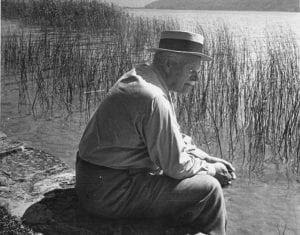It is as though consciousness were aware that the dragon is the lower half of man, which indeed and in truth is the case. Carl Jung, Letters Vol. 1, Page 489.
The ancients called the saving word the Logos, an expression of divine reason. So much unreason / was in man that he needed reason to be saved.
If one waits long enough, one sees how the Gods all change into serpents and underworld dragons in the end.
This is also the fate of the Logos: in the end it poisons us all.
In time, we were all poisoned, but unknowingly we kept the One, the Powerful One, the eternal wanderer in us away from the poison.
We spread poison and paralysis around us in that we want to educate all the world around us into reason. Carl Jung, The Red Book, Page 280.
My friends, it is wise to nourish the soul, otherwise you will breed dragons and devils in your heart. Carl Jung, The Red Book, Page 232.
After death on the cross Christ went into the underworld and became Hell. So he took on the form of the An- tichrist, the dragon. The image of the Antichrist, which has come down to us from the ancients, announces the new God, whose coming the ancients had foreseen. Carl Jung, Liber Novus, Page 242.
Christ himself compared himself to a serpent, and his hellish brother, the Antichrist, is the old dragon himself. Carl Jung, Liber Novus, Page 318.
If one waits long enough, one sees how the Gods all change into serpents and underworld dragons in the end. This is also the fate of the Logos: in the end it poisons us all. Carl Jung, Liber Novus, Page 280.
Many have wanted to get help for their sick God and were then devoured by the serpents and dragons lurking on the way to the land of the sun. Carl Jung, Liber Novus, Page 283.
Birth is difficult, but a thousand times more difficult is the hellish afterbirth. All the dragons and monstrous serpents of eternal emptiness follow behind the divine son. Carl Jung, Liber Novus, Page 287.
The universal hero myth always refers to a powerful man or god-man who vanquishes evil in the form of drag- ons, serpents, monsters, demons, and so on, and who liberates his people from destruction and death.
The narration or ritual repetition of sacred texts and ceremonies, and the worship of such a figure with dances, music, hymns, prayers, and sacrifices, grip the audience with numinous emotions and exalt the individual to an identification with the hero. Carl Jung; Man and His Symbols; Page 68.
More especially the threat to one’s inmost self from dragons and serpents points to the danger of the newly acquired consciousness being swallowed up again by the instinctive psyche, the unconscious. Carl Jung; CW 9i; para. 282.
Water is the commonest symbol for the unconscious.
The lake in the valley is the unconscious, which lies, as it were, underneath consciousness, so that it is often
referred to as the ‘subconscious,’ usually with the pejorative connotation of an inferior consciousness.
Water is the ‘valley spirit,’ the water dragon of Tao, whose nature resembles water- a yang in the yin, there- fore, water means spirit that has become unconscious.” (Carl Jung, CW 9i, para 40)
More especially the threat to one’s inmost self from dragons and serpents points to the danger of the newly acquired consciousness being swallowed up again by the instinctive psyche, the unconscious. Carl Jung; CW 9i; para. 282.
Nature gives itself pleasure, or eats itself out of sheer love, so to speak. Nature is then represented as an undivided being, a dragon or a snake biting its own tail, eating itself up from the tail end. Carl Jung, Modern Psychology, Page 42.
The dragon, for instance, did not need to be imported from China, there have been dragon myths in Europe since the earliest times. Carl Jung, Modern Psychology, Page 43.
Psychologically, however, the archetype as an image of instinct is a spiritual goal toward which the whole na- ture of man strives; it is the sea to which all rivers wend their way, the prize which the hero wrests from the fight with the dragon. Carl Jung, CW 8, Para 415


No comments:
Post a Comment